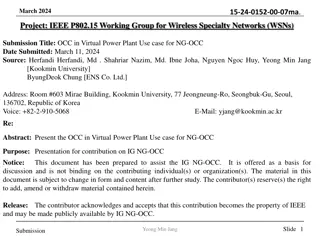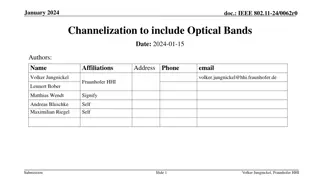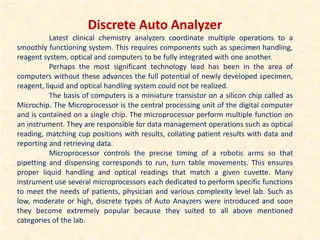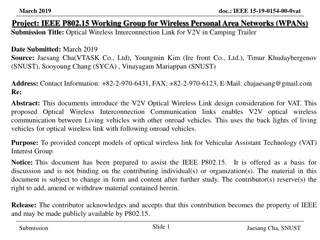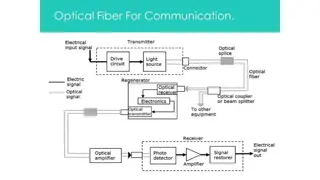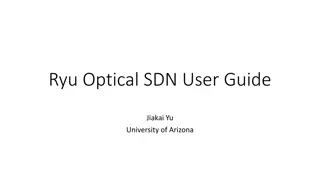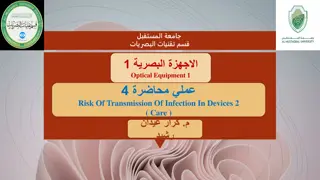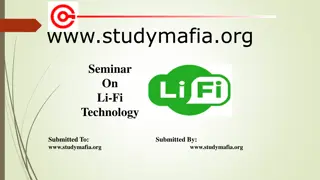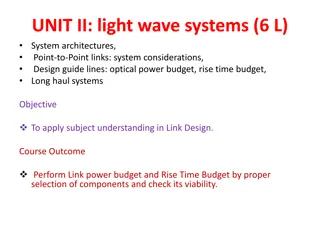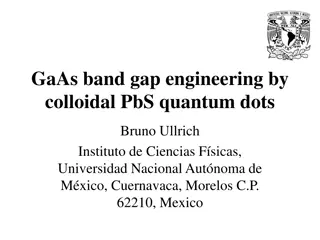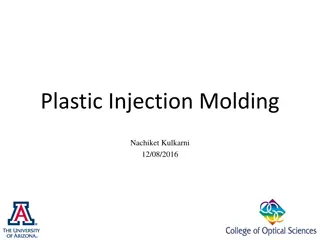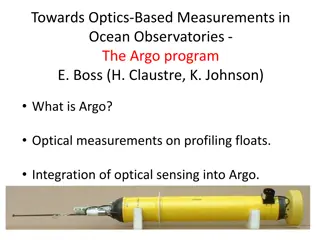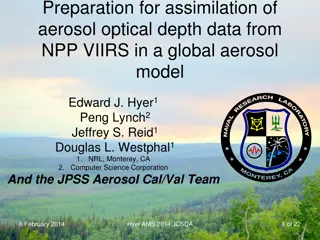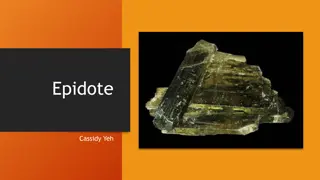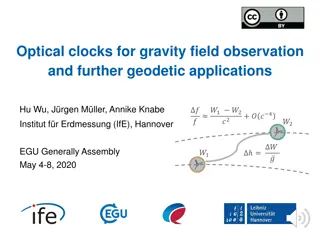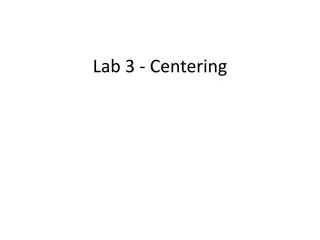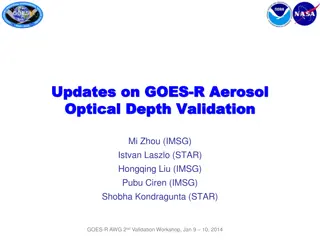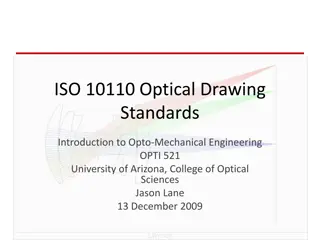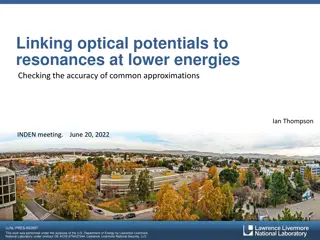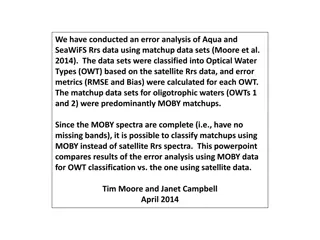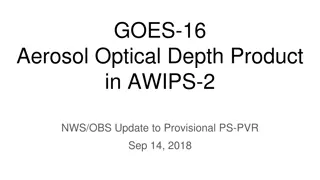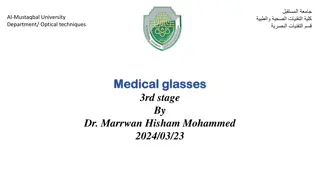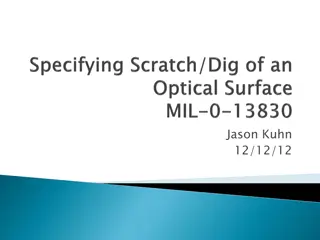Next-Generation Optical Camera Communication in Virtual Power Plants
The submission discusses the application of Next-Generation Optical Camera Communication (NG-OCC) in virtual power plants, highlighting its advantages in transmitting data efficiently and reliably in the energy sector. NG-OCC utilizes light for communication, minimizing interference risks and offeri
5 views • 8 slides
Channelization to Include Optical Bands in IEEE 802.11 Standards
This document discusses the proposal to incorporate optical bands into the channelization framework of the IEEE 802.11 standard. It aims to align the channelization approach for integrated LC with that of mm-wave technology in the IMMW scope. The contribution highlights recent works, emphasizing the
2 views • 11 slides
Advancements in Discrete Auto Analyzers for Clinical Chemistry Operations
Discrete auto analyzers integrate specimen handling, reagent systems, optical components, and computers for streamlined functionality. The innovation in computer technology, particularly microprocessors, has revolutionized these analyzers, enabling precise data management, liquid handling, and optic
0 views • 17 slides
Optical Properties of Optically Active Compounds
Circular dichroism and optical rotatory dispersion are important techniques for studying the optical properties of optically active compounds. Circular dichroism measures the differential absorption of left and right circularly polarized light components, while optical rotatory dispersion studies th
0 views • 17 slides
Understanding Optical Telescope Types and Lens-Maker's Formula
Optical telescopes utilize lenses or mirrors to collect and focus light for imaging celestial objects. The lens-maker's formula is crucial for determining the focal length of lenses, considering factors like index of refraction and radii of curvature. Different lens configurations and materials help
0 views • 17 slides
Overview of Optical Fibre Technology and Applications
Optical fibre technology, spearheaded by Dr. Prabodh Sahai Saxena, revolutionizes communication systems through light transmission. This cutting-edge technology utilizes fibre optics made of glass or plastic to carry light signals, offering advantages like high bandwidth, low signal loss, and no ele
0 views • 20 slides
Evolution of Optical Technology: From Telegraph to Photonic Integrated Circuits
The journey of optical technology evolution spans from the invention of the telegraph in 1836, through the introduction of optical fibers in 1978, to the development of photonic integrated circuits in the present era. Key milestones include the advent of optical amplifiers in 1990, the emergence of
0 views • 70 slides
Optical Wireless Interconnection Link for V2V in Camping Trailer
Introducing a design concept for Optical Wireless Communication Link for Vehicular Assistant Technology (VAT), enabling V2V communication between living vehicles and other on-road vehicles. Utilizing back lights of living vehicles, this system aims to improve visibility and safety on the road, espec
0 views • 5 slides
Fiber Optic Communication System Overview
This article presents a detailed explanation of a point-to-point fiber optic communication system, outlining the process from voice conversion to signal transmission and reception. It discusses the advantages and limitations of optical communication systems, along with numerical examples related to
5 views • 11 slides
Optical Equipment Safety Review and Hazard Analysis
This document provides an in-depth review of the safety considerations for the ATST optical equipment, focusing on potential hazards associated with the M2 Mirror, Heat Stop Assembly, and other critical components. The Preliminary Hazard Analysis identifies various risks, causes, and recommended act
0 views • 13 slides
Overview of Laser Delivery Systems for Surgical Procedures
Institute of Laser for Postgraduate Studies at the University of Baghdad, led by Assist. Prof. Dr. Lutfi Ghulam Awazli, focuses on laser delivery systems in surgical procedures. The systems discussed include optical fibers, articulated arms, hollow waveguides, and free beams. Optical fibers, compose
0 views • 10 slides
Understanding Optical Storage Technology
Optical storage technology originally designed for audio offers a capacity of 650MB, providing over 70 minutes of audio playback. Data is recorded digitally on a polycarbonate disk's surface as microscopic pits. The disk is organized in a spiral track with sectors of the same length arranged in bloc
5 views • 16 slides
Advances in Optical Bench Technology for Gravitational Wave Detectors
This content discusses the latest advancements in optical bench technology for gravitational wave detectors, focusing on precise measurements of back-scattered light, development of new optical cavities, and testing of Sagnac interferometers. Key objectives include improving suspension controls, red
0 views • 13 slides
Optical Alignment Using Beam Triangle Opti 521 Phil Scott
This presentation delves into the intricate process of optical alignment using a beam triangle, focusing on defining optical and mechanical axes, addressing alignment challenges, degrees of freedom for various elements, and the importance of setting up a beam triangle for accurate alignment. The con
0 views • 14 slides
Transimpedance Amplifiers in CMOS Technology for Optical Communications at 40 Gb/s
This research by Joseph Chong at Virginia Tech delves into the use of transimpedance amplifiers (TIAs) in CMOS technology for optical communications operating at a data rate of 40 Gb/s. The study outlines the motivation behind the project, the role of TIAs in optical receivers, TIA circuit topologie
0 views • 52 slides
Optical SDN/NFV User Guide for Network Control & Management
Explore the comprehensive user guide for Optical Software-Defined Networking (SDN) and Network Functions Virtualization (NFV) at the University of Arizona. Learn about the SDN controller interfaces, network monitoring, traffic engineering databases, and more. Discover the capabilities of the Northbo
0 views • 13 slides
Proper Care and Maintenance of Optical Equipment to Prevent Infections
Regular examination and proper cleaning of tonometer prisms are essential to reduce the risk of transmitting infections during eye examinations. Disinfection and sterilization processes are crucial in maintaining optical equipment hygiene. Different disinfectants and physical methods can be used to
0 views • 24 slides
Optical Frequency Interferometer Bench Analysis
Detailed examination of the optical setup for an Optical Frequency Interferometer (OFI) system, including the input/output configurations with various optical components such as prisms, crystals, and wave plates. The analysis focuses on the path and behavior of beams within the system, considering r
0 views • 14 slides
Understanding Li-Fi Technology: A Comprehensive Overview
Li-Fi is a cutting-edge wireless optical networking technology that utilizes LED light bulbs for data transmission. Developed by Professor Harald Haas, Li-Fi offers high-speed connectivity by modulating light imperceptibly for optical data transmission. This technology has the potential to revolutio
2 views • 14 slides
Optical Fiber Link Systems for Data Transmission Design Guide
Explore the principles of optical power budget and rise time budget in light wave systems for designing efficient point-to-point links. Understand system considerations, architecture, and major components like transmitters, regenerators, and receivers. Learn to apply subject knowledge in designing r
0 views • 53 slides
Evolution of Optical Fiber Technology
Optical fiber technology has a rich history starting from John Tyndall's demonstrations in 1870 to the development of flexible fiberscopes by Hopkins and Kapany. This technology revolutionized communication systems and medical diagnostics, enabling the transmission of information through thin glass
0 views • 85 slides
Optical Image Formation: Principles and Conditions
Understanding the principles and conditions governing optical image formation, including the role of broad bundles of rays, wave surfaces, magnification ratios, and axially-symmetric optical systems. Explore the conditions for imaging line segments, optical path lengths, and the general criteria for
0 views • 13 slides
Exploring the Impact of PbS Quantum Dots on GaAs for Tailored Photonic Applications
This research delves into the alteration of GaAs emission through the integration of PbS quantum dots, emphasizing the optical properties and absorption edge engineering. The unique characteristics of PbS and GaAs make them ideal candidates for enhancing optical fibers and optoelectronic devices. Th
0 views • 19 slides
Optical Testing Setup Procedures for Vacuum Windows and Polarizers
Detailed procedures for optical testing setups involving vacuum windows, polarizers, rotation stages, translation stages, photodiodes, scopes, power meters, and more. The process includes preparing the initial state, rotating analyzers, monitoring transmission, and verifying the direction and magnit
0 views • 5 slides
Understanding Plastic Injection Molding for Optical Components
Plastic injection molding is a cost-effective method for mass-producing optical components, offering an economical alternative to glass. This process involves designing molds, considering factors like shrinkage and surface equations, ensuring smooth mold flow, and regulating fluid flow through gates
0 views • 12 slides
Optical Fiber Calibration System & Adaptive Power Supply by J. Cvach
Introduction to an optical fiber calibration system and adaptive power supply developed by J. Cvach from the Institute of Physics, ASCR, Prague. The system includes an LED driver, notched fibers, and adaptive power supply for various applications, such as the calibration of the CALICE AHCAL and LHCb
0 views • 13 slides
Advancements in Optical Measurements for Ocean Observatories: The Argo Program
The Argo program integrates optical sensing into ocean observatories using profiling floats to gather data from the deep sea. With nearly 1,000,000 profiles to date, the Argo Observing System offers a global, real-time monitoring solution. Utilizing optics on profiling floats has enabled observation
0 views • 12 slides
Assimilation of NPP VIIRS Aerosol Optical Depth Data in Global Model
Preparation and assimilation of aerosol optical depth data from NPP VIIRS into a global aerosol model, including product descriptions, data requirements, processed observations, and conclusions on VIIRS aerosol products. Details on AOT, APSP, SM classification, and environmental data records are cov
0 views • 19 slides
All About Epidote: Physical, Chemical, and Optical Properties
Epidote, a silicate mineral, is a rock-forming mineral with a crystal structure consisting of isolated and paired silica tetrahedra. It is found in rocks like epidosite and unakite, displaying colors of yellowish-green, green, brownish-green, or black. This mineral has a vitreous luster, a hardness
0 views • 11 slides
Optical Clocks for Gravity Field Observation and Geodetic Applications
Optical clocks play a crucial role in observing gravity fields and have various geodetic applications. From comparing space-to-ground and space-to-space clocks to detecting mass loss in Greenland, these clocks offer high-frequency sampling data for precise measurements. They also aid in unifying hei
0 views • 10 slides
Lab 3: Centering Optical Elements & Systems with Precision
Centering optical elements and systems accurately is crucial for optical alignment processes. This lab focuses on using an air bearing rotary table and dial indicators to achieve precise centering. The equipment used includes PSM, displacement indicators, adjustment screws, and magnetic mounts. Prop
0 views • 14 slides
Optical Signatures of Climate Change Impacts on Phytoplankton
Explore the optical signatures of climate change impacts on phytoplankton through images showing differences in primary production, reflectance ratios, community changes, and trends in various oceanic regions. The data visualizations provide insights into the effects of climate change on phytoplankt
0 views • 10 slides
Understanding Nonlinear Optical Processes in Semiconductors
Exploring the complexities of nonlinear optics in the perturbative and non-perturbative regimes, this research delves into the generation of harmonics, optical Kerr effects, and extreme nonlinear optical phenomena utilizing phase-controlled electromagnetic pulses. The work also investigates the inte
0 views • 15 slides
Updates on GOES-R Aerosol Optical Depth Validation Activities
Generated proxy data algorithm enhancements for post-launch validation activities were discussed at the GOES-R AWG 2nd Validation Workshop in January 2014. The use of MODIS reflectances as a proxy for ABI to retrieve Aerosol Optical Depth (AOD) was emphasized, along with the importance of AERONET gr
0 views • 25 slides
Understanding ISO 10110 Optical Drawing Standards
ISO 10110 Optical Drawing Standards provide guidelines for preparing drawings of optical elements and systems, essential for interpreting optical drawings accurately. The standard includes 13 parts covering aspects such as material imperfections, surface form tolerances, and more. Compliance with IS
0 views • 17 slides
Exploring Optical Potentials and Resonances at Lower Energies
Investigating the accuracy of common approximations in linking optical potentials to resonances at lower energies. The study focuses on neutron reactions with 14N as a test case, transitioning from R-matrix theory to Hauser-Feshbach models and evaluating known levels and level densities. Key topics
0 views • 22 slides
Comparison of Aqua and SeaWiFS Rrs Data Error Analysis Using MOBY Data
An error analysis was conducted on Aqua and SeaWiFS Rrs data using matchup data sets classified into Optical Water Types (OWT). The analysis compared results of OWT classification using MOBY data versus satellite data, highlighting differences in error metrics such as RMSE and Bias. Aqua and SeaWiFS
1 views • 12 slides
Overview of GOES-16 Aerosol Optical Depth Products and SoCal/Baja Weather Conditions
This content provides information on various products derived from the GOES-16 satellite, including aerosol optical depth measurements in different sectors and menus available. It also includes weather conditions in the Southern California/Baja region on September 9, 2018, as reported by the Phoenix
0 views • 7 slides
Understanding Decentration in Optical Techniques for Medical Glasses
Decentration in optical lenses refers to adjusting the optical center of the lens to align directly in front of the patient's eye. This process is necessary when the frame pupillary distance (PD) or the patient's PD differs. The formula for calculating decentration in single-vision lenses is provide
0 views • 16 slides
Understanding Surface Scratch Specifications in Optical Elements
This informative content delves into the specifications for surface scratches on optical elements, highlighting criteria such as scratch width, length limitations, and scratch density requirements. It explains how to evaluate compliance with these specifications using examples and images, emphasizin
0 views • 14 slides
